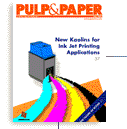|

W.L. Craig Campbell is a partner at PricewaterhouseCoopers’ Vancouver, B.C., office. He is responsible for the Global Forest & Paper Practices’ global benchmarking initiatives and e-business.
|

Thriving in the new millennium
The following is excerpted from a presentation given at the 13th Annual Pacific Northwest Forest Industry Conference. The first part of the presentation discussed financial performance and capital investment for British Columbia, Pacific Northwest, and global paper companies.
Let’s look at the capital invested in some other industries, comparing General Motors, Amazon.com, and the 100 largest forest and paper companies in the world (aggregated in one column of the table).
Amazon.com is the poster child of the dotcoms. Look at how little they have invested. And they spend virtually all their capital on acquiring customers. And none of them turn a profit.
However, I’d like to spend a moment talking about the auto industry because it is going through an amazing transformation. They have had to compete in the same capital market as us. And they have also been feeling the pressure of ROCE and shareholder value. They have been pushed to change their business model. General Motors and Ford used to be “automobile manufacturers.” Now, their business is design, branding, and marketing. They have outsourced all their parts manufacturing, and recently even the assembly to others-for example, Magna International.
And recently they have plunged into the digital world in a big way. In fact, they are moving so far from their traditional business model of a manufacturing company that they are now on the verge of being the largest e-business player in the world.
Some indicators of this include:
- The automobile supplier network will have US$250 billion in activity in year one. This will expand as other automobile manufacturing companies (e.g., Toyota) come on board.
- The customer interface is shifting from dealers and inventory to delivering a customized, internet-ordered car in four days.
- Partnerships are being built with companies such as America Online and Yahoo!
- All Ford employees are being provided with home computers and internet access to allow all of them to be completely “e-literate.”
Too radical for the forest products industry? Nortel–after 100 years of being a manufacturer–is letting someone else do it. Too high tech? How about Sarah Lee, which is outsourcing the manufacture of one of its prime offerings–cup cakes.
“NEW” INDUSTRY INFLUENCES. I put quotations around “new” because some of these influences have been around for awhile. Influences include:
- E-business portals and exchanges, which present a new business model
- Changing customer demands, giving rise to what could be called “big box” stores
- Changing customer preferences, which has manifested itself in such ways as shrinking newspapers
- Environmental issues and certification.
The point here is that the world is moving very quickly, and there are non-traditional players that want to elbow their way into our business and take out some bits for themselves.
Some predictions for 2000 include continued global consolidation with more than one mega–merger (two of the top ten) forming a US$35 billion company. Another prediction is for a restructuring of the supply chain, triggered by e–business–for example, a convergence of big box stores, wholesalers, portals, and manufacturers. A third prediction is that profitability will be improved over 1999 but still without an improved return on capital employed.
But in today’s economy, business is not about beating the small. It is about beating the slow. Our industry has to look forward and make some predictions about how the new economy will impact us and how we can use these new variables to help us return the cost of our capital.
| Amazing Financial Facts (U.S.$millions–year-end December 1999) |
| |
GM |
Amazon.com |
Forest & Paper
|
| Total Assets |
$274,000 |
$2,472 |
$380,000 |
| Total Sales |
$177,000 |
$1,640 |
$286,000 |
| Revenue |
|
|
|
| Profit |
$5,922
|
–$720 |
$11,000 |
| What They’re |
$49,000 |
$26,000 |
$230,000 |
| Worth |
|
|
|
|
Source: Company reports and public sources; PwC 1999 Global Forest & Paper Survey
|

|





